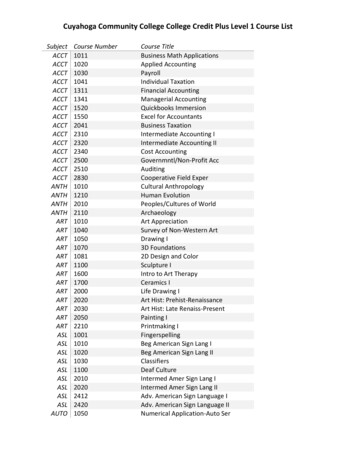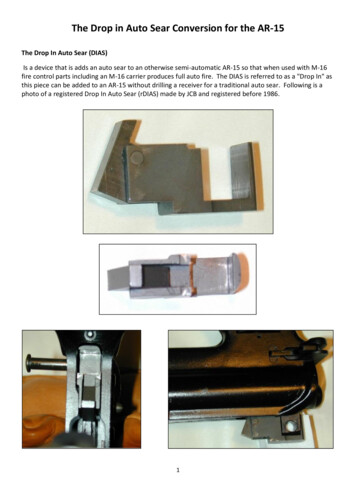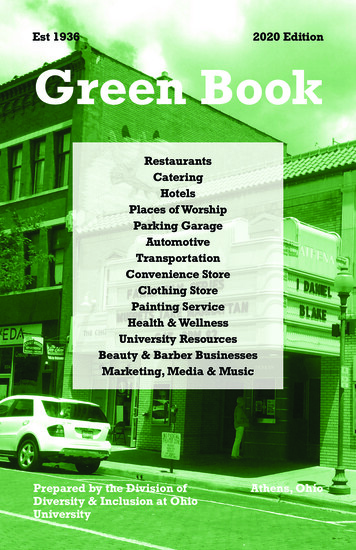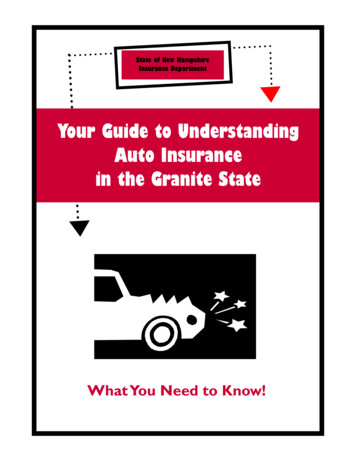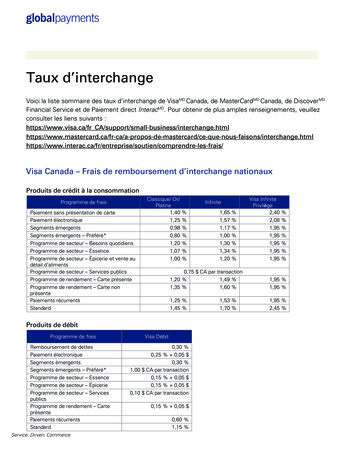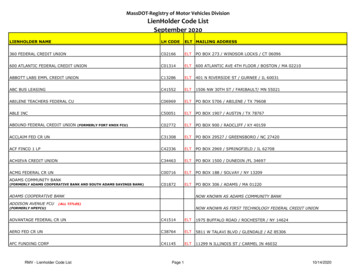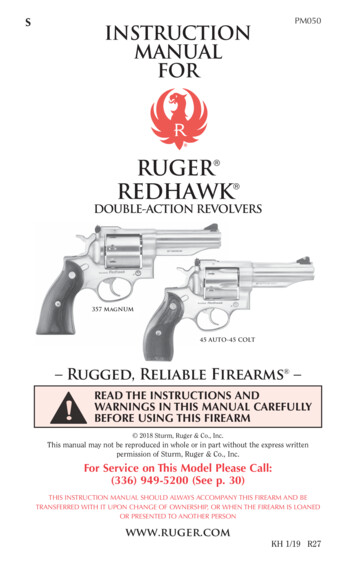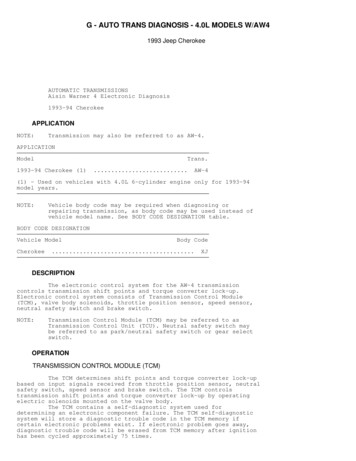
Transcription
G - AUTO TRANS DIAGNOSIS - 4.0L MODELS W/AW41993 Jeep CherokeeAUTOMATIC TRANSMISSIONSAisin Warner 4 Electronic Diagnosis1993-94 CherokeeAPPLICATIONNOTE:Transmission may also be referred to as AW-4.APPLICATION ModelTrans.1993-94 Cherokee (1).AW-4(1) - Used on vehicles with 4.0L 6-cylinder engine only for 1993-94model years. NOTE:Vehicle body code may be required when diagnosing orrepairing transmission, as body code may be used instead ofvehicle model name. See BODY CODE DESIGNATION table.BODY CODE DESIGNATION Vehicle ModelCherokeeBody Code.XJ DESCRIPTIONThe electronic control system for the AW-4 transmissioncontrols transmission shift points and torque converter lock-up.Electronic control system consists of Transmission Control Module(TCM), valve body solenoids, throttle position sensor, speed sensor,neutral safety switch and brake switch.NOTE:Transmission Control Module (TCM) may be referred to asTransmission Control Unit (TCU). Neutral safety switch maybe referred to as park/neutral safety switch or gear selectswitch.OPERATIONTRANSMISSION CONTROL MODULE (TCM)The TCM determines shift points and torque converter lock-upbased on input signals received from throttle position sensor, neutralsafety switch, speed sensor and brake switch. The TCM controlstransmission shift points and torque converter lock-up by operatingelectric solenoids mounted on the valve body.The TCM contains a self-diagnostic system used fordetermining an electronic component failure. The TCM self-diagnosticsystem will store a diagnostic trouble code in the TCM memory ifcertain electronic problems exist. If electronic problem goes away,diagnostic trouble code will be erased from TCM memory after ignitionhas been cycled approximately 75 times.
NOTE:Diagnostic trouble code may be referred to as fault code.Diagnostic trouble codes can be retrieved using a DiagnosticReadout Box-II (DRB-II). After repairing an electrical system problem,stored diagnostic trouble code must be cleared from TCM memory.The TCM is located behind right side of instrument panel onCherokee. See Fig. 1.Fig. 1: Transmission Control Module (TCM) I.D. (Cherokee)Courtesy of Chrysler Corp.VALVE BODY SOLENOIDSValve body solenoids, mounted on the valve body, are outputdevices controlled by signals received from the TCM. See Fig. 2. TheNo. 1 and 2 valve body solenoids control transmission shifts while theNo. 3 valve body solenoid is used for torque converter lock-up.When No. 1 and 2 valve body solenoids are energized,solenoid plunger moves from seat. This opens the drain port andreleases line pressure. When either valve body solenoid is deenergized, plunger closes the drain port.The No. 3 valve body solenoid operates in reverse. When No. 3valve body solenoid is de-energized, solenoid plunger moves away fromseat. This opens the drain port and releases line pressure. When No. 3valve body solenoid is energized, the plunger closes the drain port.NOTE:For valve body solenoid usage, see VALVE BODY SOLENOIDAPPLICATION table.VALVE BODY SOLENOID APPLICATION (1)
Shifter PositionNo. 1 Solenoid"D" (Drive)1st Gear .2nd Gear .3rd Gear .4th Gear ."3"1st Gear .2nd Gear .3rd Gear ."1-2"1st Gear .2nd Gear ."R" (Reverse) ."N" Or "P" .No. 2 SolenoidON . OFFON . ONOFF . ONOFF . OFFON . OFFON . ONOFF . ONONONONON. OFF. ON. OFF. OFF(1) - Valve body contains 3 valve body solenoids. See Fig. 2. No. 1and 2 valve body solenoids are used for controlling transmissionshifts. No. 3 valve body solenoid is used for torque converter lock-uponly. Fig. 2: Identifying Valve Body SolenoidsCourtesy of Chrysler Corp.BRAKE SWITCH
Brake switch is an input device mounted above the brakepedal. When brake pedal is operated, brake switch delivers an inputsignal to the TCM. The TCM uses input signal for controlling No. 3valve body solenoid for torque converter lock-up.NEUTRAL SAFETY SWITCHNOTE:Neutral safety switch may be referred to as park/neutralsafety switch or gear select switch.Neutral safety switch is an input device mounted on thetransmission manual valve shaft. Neutral safety switch delivers aninput signal to TCM, indicating transmission manual valve gearposition.SPEED SENSORSpeed sensor, mounted in adapter housing or extensionhousing, is an input device consisting of speed sensor rotor and speedsensor. Speed sensor rotor is mounted on transmission output shaft.Input signal is delivered from speed sensor to TCM with eachrevolution of transmission output shaft. The TCM uses input signal forcontrolling transmission operation.THROTTLE POSITION SENSOR (TPS)The TPS, mounted on throttle body, determines throttleposition and delivers an input signal to TCM. The TCM uses inputsignal for controlling transmission upshifts and torque converterlock-up.SELF-DIAGNOSTIC SYSTEMDIAGNOSTIC PROCEDUREWhen performing vehicle diagnosis:*Ensure transmission fluid level is correct and fluid is neithercontaminated nor aerated.Ensure shift cable is properly adjusted. Refer to the appropriateTRANSMISSION SERVICING - A/T article in this section.Ensure battery is fully charged.Perform visual inspection, ensuring all electrical connections attransmission, TCM, throttle position sensor, neutral safetyswitch, speed sensor and brake switch are clean and properlyinstalled.Perform TEST 1A - VERIFICATION OF COMPLAINT under TROUBLESHOOTING CHARTS in this article.Repair diagnostic trouble codes in order displayed.Always perform TEST 2A - VERIFICATION TEST after repair iscompleted. See TEST 2A - VERIFICATION TEST under TROUBLESHOOTING CHARTS in this article.******RETRIEVING DIAGNOSTIC TROUBLE CODESNOTE:Manufacturer recommends using Chrysler’s Diagnostic ReadoutBox-II (DRB-II) with proper cartridge for system diagnosis.Other after-market scan tools may be used for systemdiagnosis. The following procedure is for DRB-II scan toolusage. Use manufacturer’s instruction for operating theDRB-II scan tool. When retrieving diagnostic trouble codes
using DRB-II, you must first enter AW4 MENU and thenretrieve diagnostic trouble codes.NOTE:Ensure TEST 1A - VERIFICATION OF COMPLAINT is performed whentrouble shooting the vehicle. This test checks fordiagnostic trouble codes with vehicle stationary and duringroad test. See TEST 1A - VERIFICATION OF COMPLAINT underTROUBLE SHOOTING CHARTS.NOTE:The DRB-II scan tool can be used in several different modesusing manufacturer’s instructions to activate systemcomponents and perform several tests on transmission. SeeDRB-II OPERATING MODES.Entering AW4 MENU1) Ensure ignition is off. Connect DRB-II to 6-pintransmission diagnostic connector. See Fig. 3. Transmission diagnosticconnector is located on driver’s side of instrument panel, aboveaccelerator pedal.Fig. 3: Diagnostic Connector & Terminals I.D. (Cherokee)Courtesy of Chrysler Corp.2) Turn ignition on. Copyright date and diagnostic programwill be briefly displayed. If DRB-II displays an error message,proceed to DRB-II PROBLEMS & ERROR MESSAGES. The following arepossible error messages that may appear.**CARTRIDGE ERRORHIGH BATTERY
***KEYPAD TEST FAILURELOW BATTERYRAM TEST FAILURE3) If no error messages appear, display will read as followsafter a few seconds: 1) VEHICLES TESTED, 2) HOW TO USE, 3) CONFIGUREand 4) SELECT SYSTEM.4) Select 4) SELECT SYSTEM to enter diagnostic system. Oncein SELECT SYSTEM, select 2) TRANSMISSION to enter transmission.Display will read 1) EATX and 2) AW4.5) Select 2) AW4. After a few seconds display will change toread AW4, VERSION 01. After a few seconds, display will read AW4 MENU,1) SYSTEM TEST and 2) READ FAULTS. If DOWN ARROW is depressed 3 times,display will read as follows: 3) STATE DISPLAY, 4) ACTUATOR TESTS and5) ADJUSTMENTS.NOTE:The ACTUATOR TESTS and ADJUSTMENTS cannot be used whendiagnosing the AW-4 transmission.Retrieving Diagnostic Trouble Codes1) Select 2) READ FAULTS from AW4 MENU. If no diagnostictrouble code exists, display will read as follows: AW4 FAULTS, NOFAULTS DETECTED.2) If diagnostic trouble code exists, the following messagewill be displayed: 1 OF 3 FAULTS. This number will vary depending onnumber of diagnostic trouble codes stored in the TCM memory.3) Diagnostic trouble code and message will be displayed.Press DOWN ARROW key to display next diagnostic trouble code. Toidentify diagnostic trouble code, seeDIAGNOSTIC TROUBLE CODE IDENTIFICATION table.NOTE:See TROUBLE SHOOTING CHARTS to diagnose faults indicated bytrouble codes.NOTE:Valve body solenoid diagnostic trouble code 700 may appearin a FAULT PRESENT or FAULT STORED status. Status will bedisplayed along with diagnostic trouble code. Diagnostictrouble code must be diagnosed depending on the status. SeeTEST 1A - VERIFICATION OF COMPLAINT under TROUBLESHOOTING CHARTS.DIAGNOSTIC TROUBLE CODE IDENTIFICATION Trouble CodeProblem Area700 (1) . Valve Body Solenoid702 . Speed Sensor703 . (2) Gear Select Switch705 . Throttle Position Sensor706 . Brake Switch707 . Wrong TCM Or TCU(1) - Trouble code may apply to individual valve body solenoids. Valvebody solenoid may be referred to as S1 for No. 1, S2 for No. 2 and S3for No. 3.(2) - Gear select switch is the same as the neutral safety switch. CLEARING DIAGNOSTIC TROUBLE CODES1) Once all diagnostic trouble codes have been obtained,diagnostic trouble code(s) can be erased from TCM memory bydisconnecting electrical connector from TCM for at least 15 seconds.
CAUTION: DO NOT disconnect battery, as data stored in other vehiclecontrol modules will be lost.2) The TCM is located behind right side of instrument panelon Cherokee. See Fig. 1.DRB-II OPERATING MODESNOTE:The DRB-II can be operated in several different modesto perform various tests. Except for voltmeter/ohmmeterand HOW TO USE modes, all other operating modes areselected from AW4 MENU. See ENTERING AW4 MENU underRETRIEVING DIAGNOSTIC TROUBLE CODES.VOLTMETER/OHMMETER MODETo access voltmeter/ohmmeter mode, connect Red volt-ohmmetertest lead to Red port at top right corner of DRB-II. There are 2different ports on top of DRB-II; ensure test lead is connected toproper port. Access voltmeter or ohmmeter mode using manufacturer’sinstructions.NOTE:The DRB-II is grounded through transmission diagnosticconnector and only one test lead is required. Whendiagnosing transmission, an external volt-ohmmeter maysometimes be required.HOW TO USE MODE1) This mode gives instructions on DRB-II usage. To enterthis mode, see steps 1) through 4) of ENTERING AW4 MENU underRETRIEVING DIAGNOSTIC TROUBLE CODES. Select 2) HOW TO USE.2) A series of screens will be displayed explaining DRB-IIkey usage for system diagnosing.SYSTEM TEST MODENOTE:SYSTEM TEST mode consists of a stationary test anda road test. The SYSTEM TEST mode must be selectedfrom AW4 MENU. Refer to ENTERING AW4 MENU underRETRIEVING DIAGNOSTIC TROUBLE CODES.1) Stationary test monitors transmission system data, currentvalve body solenoid failures, switch failures, correct TCMapplication, calibration and operation. Road test checks all valvebody solenoids and speed sensor.2) Technician will be instructed to place shift lever in eachgear position, starting by shifting into 1-2 position. Oncetransmission is in Park, brake pedal must be depressed to check brakeswitch.3) After brake switch is checked, technician will beinstructed to slowly depress throttle. DRB-II will display 7 asterisks(*******) corresponding to throttle position. While depressingaccelerator, Throttle Position Sensor (TPS) sweeps through entirerange of positions required by the TCM.4) A corresponding asterisk will be cleared from DRB-IIdisplay as each throttle position is sensed by TCM. Several attemptsmay be required to clear all asterisks from the display, depending onhow fast accelerator is depressed.5) After throttle position is checked, technician will beinstructed to drive the vehicle. The DRB-II will indicate if a
requested action is seen by the TCM. If technician is requested toperform a particular operation and TCM does not acknowledge theaction, press ENTER key to continue testing.6) The TCM will instruct technician to accelerate vehicle atlight throttle to ensure transmission shifts through all gears,indicating proper valve body solenoid operation.7) During road test, ensure vehicle can be accelerated slowlyand evenly to allow transmission to enter all gear ranges withoutdownshifting or braking. If a failure is sensed, a diagnostic troublecode will be displayed on DRB-II.NOTE:If TCM senses a failure, control logic activates a specifiedvalve body solenoid to obtain a certain gear depending onfailure. Because transmission diagnostic trouble codes aredisplayed one at a time, multiple diagnostic trouble codesmust be identified by retesting transmission.STATE DISPLAY MODENOTE:STATE DISPLAY mode must be selected from AW4 MENU. SeeENTERING AW4 MENU under RETRIEVING DIAGNOSTIC TROUBLE CODES.Select 3) STATE DISPLAY on DRB-II.Module InformationWhen selecting module information option, the TCM versionwill be indicated by a 2-digit number. Information can be used toverify proper TCM application.Sensor1) When selecting sensor option, TPS and RPM indications willbe shown. The TPS indicator will display a 7 segment bar graph,indicating TPS position and throttle plate angle.2) A properly operating TPS should indicate 7 segmentsthrough full throttle travel. The RPM indicator will displaytransmission output shaft revolutions per minute.Brake Switch Or Input/OutputDisplay indicates brake switch status, indicating whetherbrake pedal is applied or released. Display also indicates shift leverposition, whether a valve body solenoid is on or off and presenttransmission operating gear.DRB-II PROBLEMS & ERROR MESSAGESCARTRIDGE ERROR1) If CARTRIDGE ERROR message is displayed, disconnect DRB-IIfrom transmission diagnostic connector. DO NOT touch keys on DRB-IIkeypad. Reconnect DRB-II to transmission diagnostic connector and notedisplay.2) If CARTRIDGE ERROR message is displayed, replace DRB-IIcartridge and proceed with diagnostics. If KEYPAD TEST FAILURE messageis displayed, replace DRB-II and proceed with diagnostics.HIGH BATTERYIf HIGH BATTERY message is displayed, use external voltmeterto check battery voltage at battery terminals. If battery voltage is11.7-13.0 volts, replace DRB-II. If battery voltage is not 11.7-13.0volts, check charging system.KEYPAD TEST FAILURE
1) If KEYPAD TEST FAILURE message is displayed, disconnectDRB-II from transmission diagnostic connector. DO NOT touch keys onDRB-II keypad. Reconnect DRB-II to transmission diagnostic connectorand note display.2) If KEYPAD TEST FAILURE message is not displayed, proceedwith diagnostics. If KEYPAD TEST FAILURE message is displayed, replaceDRB-II and proceed with diagnostics.LOW BATTERYIf LOW BATTERY message is displayed, use external voltmeterto check battery voltage at battery terminals. If battery voltage is11.7-13.0 volts, replace DRB-II. If battery voltage is not 11.7-13.0volts, check charging system.RAM TEST FAILURE1) If RAM TEST FAILURE message is displayed, disconnect DRBII from transmission diagnostic connector. DO NOT touch keys on DRB-IIkeypad. Reconnect DRB-II to transmission diagnostic connector and notedisplay.2) If RAM TEST FAILURE message is not displayed, proceed withdiagnostics. If RAM TEST FAILURE message is displayed, replace DRB-IIand proceed with diagnostics. If KEYPAD TEST FAILURE message isdisplayed, replace DRB-II and proceed with diagnostics.COMPONENT TESTINGBRAKE SWITCH TESTBrake switch is mounted above brake pedal. When brake pedalis operated, brake switch delivers an input signal to TCM. The TCMuses input signal for controlling No. 3 valve body solenoid for torqueconverter lock-up. No other information is available frommanufacturer.NOTE:For proper brake switch adjustment, see BRAKE SWITCH R & Iunder REMOVAL & INSTALLATION.NEUTRAL SAFETY SWITCH TESTNOTE:Neutral safety switch may be referred to as park/neutral orgear select switch. For proper neutral safety switchadjustment, see NEUTRAL SAFETY SWITCH R & I under REMOVAL &INSTALLATION.Disconnect electrical connector. Note terminalidentification. See Fig. 4. Using ohmmeter, check continuity betweenspecified terminals in relation to shift lever position. See theNEUTRAL SAFETY SWITCH CONTINUITY SPECIFICATIONS table. Replace neutralsafety switch if continuity is not as specified.NEUTRAL SAFETY SWITCH CONTINUITY SPECIFICATIONS Shift Lever PositionContinuity Between TerminalsPark . "B" &Reverse . "A" &Neutral . "B" &Drive .3 . "A" &"C""E""C"( 1)"G"
1-2."A" & "H"(1) - No continuity should exist between any terminals. Fig. 4: Identifying Neutral Safety Switch TerminalsCourtesy of Chrysler Corp.SPEED SENSOR TEST1) Disconnect electrical connector at speed sensor located onadapter housing or extension housing. Connect ohmmeter leads betweenspeed sensor electrical terminals.2) Rotate transmission output shaft and note ohmmeterreading. Ohmmeter needle should fluctuate to indicate speed sensoroperation. Replace speed sensor if no reading is obtained.THROTTLE POSITION SENSOR (TPS) TESTNOTE:Digital voltmeter must be used to check TPS.1) Note location of TPS electrical connector. See Fig. 5.Turn ignition on. Using digital voltmeter, check output voltage atcenter terminal with throttle plate closed (idle position) and wideopen (full throttle).2) With throttle plate closed (idle position), output voltageshould be greater than 200 millivolts. With throttle plate wide open(full throttle), output voltage should be less than 4.8 volts.3) Ensure output voltage gradually increases as throttleplate is moved from closed to wide open throttle. If no voltageexists, check for defective wiring circuits or connections. ReplaceTPS if defective.
Fig. 5: Identifying TPS Electrical ConnectorCourtesy of Chrysler Corp.VALVE BODY SOLENOID TESTWith oil pan removed, disconnect electrical connector fromvalve body solenoid. Using ohmmeter, check resistance between valvebody solenoid electrical terminal and solenoid mounting bracket.Replace valve body solenoid if resistance is not 11-15 ohms.TROUBLE SHOOTING CHARTS & CODE CHARTSNOTE:Following trouble shooting charts and illustrations arecourtesy of Chrysler Corp. Always start by performingTEST 1A - VERIFICATION OF COMPLAINT. When diagnosingtransmission, it may be necessary to verify TCM connectorterminals, circuits and function, See Fig. 6.NOTE:When using trouble shooting charts, Transmission ControlModule (TCM) may be referred to as Transmission Control Unit(TCU). Diagnostic trouble code may be referred to as faultcode. Neutral safety switch may be referred to aspark/neutral or gear select switch.
Fig. 6: TCM Connector Terminals I.D., Circuits & FunctionsCourtesy of Chrysler Corp.TEST 1A - VERIFICATION OF COMPLAINTNOTE:ALWAYS start diagnosis with the most recent code.1) Begin your testing of the transmission with a thoroughvisual inspection.2) Connect the DRB-II to the transmission diagnostic
connector. See RETRIEVING DIAGNOSTIC TROUBLE CODES under SELFDIAGNOSTIC SYSTEM for diagnostic connector location.CAUTION: If the vehicle is in 3rd or OD position and feelslike it is stuck in 3rd or jumping from 2-1 or 3-1, performTEST 10A - TESTING FOR INTERMITTENT SPEED SENSORS .3) With the DRB-II, perform SYSTEM TEST. See SYSTEM TEST MODEunder DRB-II OPERATING MODES.4) The DRB-II will instruct you to do some actions during theSystem Test. The DRB-II will then look for the action to happen andautomatically go to the next test function. If you perform therequired action and the DRB-II does not move to the next function,press ENTER. The DRB-II will continue the testing.5) When the DRB-II states "VEHICLE DRIVE", the vehicle bemust be driven at a speed above 4 miles per hour to ensure accuratetesting of the vehicle speed sensor. Afterwards, the DRB-II willdisplay any fault codes that may be present.6) When the system test is complete, if there are any faultcodes present, the DRB-II will automatically display the code(s).7) There are two types of faults for the transmissionsolenoids. They are displayed as "FAULT STORED" and "FAULT PRESENT".Note that the tests are different in the chart below.8) Perform the tests shown below in response to the indicatedfault codes.NOTE:ALWAYS start diagnosis with the most recent code.CODE-TO-TEST MENUCODE-TO-TEST MENU Code:Solenoid Affected:Fault Status:Perform: NoneNone AffectedNo FaultsTEST 2A 700Solenoid No. 1Fault PresentTEST 4A 700Solenoid No. 1Fault StoredTEST 3A 700Solenoid No. 2Fault PresentTEST 4B 700Solenoid No. 2Fault StoredTEST 3A 700Solenoid No. 3Fault PresentTEST 4C 700Solenoid No. 3Fault StoredTEST 3A 702Speed Sensor Fault"TEST 5A 703Gear Select Fault"TEST 6A 705TPS Fault"TEST 7A 708Wrong TCU"TEST 9A TEST 2A - VERIFICATION TESTNOTE:Perform TEST 1A - VERIFICATION OF COMPLAINTbefore proceeding.This test verifies the correct operation of the AW4
transmission. It must be performed after finding no faults using theDRB-II, and after a vehicle repair has been made.1) Turn ignition key to "OFF".2) Hold the MODE key and press the ATM key on the DRB-II atthe same time to restart the DRB-II.3) Turn ignition key to "ON".4) Reconnect all previously disconnected connectors.5) Verify that the AW4 transmission control unit is properlymounted.6) Make sure the transmission fluid is at the proper level.Check the fluid with the transmission temperature hot, the vehicle onlevel ground, and the gear selector in neutral.7) If any repairs have been made, test the vehicle asinstructed in TEST 1A - VERIFICATION OF COMPLAINT., and read thefaults using the DRB-II. If there are any fault messages present,repeat TEST 1A - VERIFICATION OF COMPLAINT.TEST 3A - STORED DIAGNOSTIC TROUBLE CODES TESTNOTE:Perform TEST 1A - VERIFICATION OF COMPLAINTbefore proceeding.1) At this point, the Visual Inspection has been performed, a"FAULT STORED" code has been found and the vehicle has been testdriven. The fault code is not "FAULT PRESENT", so it cannot beconsidered a CURRENT or HARD fault.2) All solenoid circuits are in the same harness and a commonground wire is used for the solenoids. Use the following figures toidentify the harness and connector to inspect. See Fig. 7 and 8. ifall 3 solenoid faults are present, repair the Black wire (Cherokee)ground wire open condition.3) Carefully inspect the entire suspected circuit. Payparticular attention to connectors, corrosion, accident damage, andimproper or missing parts.4) If any problems are found, make the appropriate repair.Then perform TEST 1A using the DRB-II.5) Erase fault codes.6) If no problems are found, perform the SYSTEM TEST usingthe DRB-II. Re-check for fault codes. If there are no fault codes,perform TEST 2A - VERIFICATION TEST. If fault code(s) return, performTEST 1A - VERIFICATION OF COMPLAINT.Fig. 7:Test 3A - Location of 7-Way Connector
Fig. 8:Test 3A - View of 7-Way Connector (Cherokee)TEST 4A - CODE 700 - S1 SOLENOID CIRCUIT
Fig. 9:Test 4A - Code 700, Flow Chart (1 of 2)
Fig. 10:Test 4A - Code 700, Schematic (Cherokee)Fig. 11:Test 4A - Code 700, TCU 32-Way Connector (Cavity 16)
Fig. 12:Test 4A - Code 700, Location of 7-Way ConnectorFig. 13:Test 4A - Code 700, Location of Pin "B" (Ground)
Fig. 14:Test 4A - Code 700, Flow Chart (2 of 2)
Fig. 15:Test 4A - Code 700, Schematic (Cherokee)Fig. 16:Test 4A - 7-Way Connector Cavity "G" (Cherokee)
Fig. 17:Test 4A - Code 700, TCU 32-Way Connector (Cavity 16)Fig. 18:Test 4A - Code 700, Location of Solenoids
Fig. 19:Test 4A - Code 700, Solenoid No. 1 Wire (Cavity "G")Fig. 20:Test 4A - Code 700, Testing S1 Control WireTEST 4B - CODE 700 - S2 SOLENOID CIRCUIT
Fig. 21:Test 4B - Code 700, Flow Chart (1 of 2)
Fig. 22:Test 4B - Code 700, Schematic (Cherokee)Fig. 23:Test 4B - Code 700, TCU 32-Way Connector (Cavity 15)
Fig. 24:Test 4B - Code 700, Location of 7-Way Connector
Fig. 25:Test 4B - Code 700, Flow Chart (2 of 2)
Fig. 26:Test 4B - Code 700, Schematic (Cherokee)Fig. 27:Test 4B - 7-Way Connector Cavity "F" (Cherokee)
Fig. 28:Test 4B - Code 700, TCU 32-Way Connector (Cavity 15)Fig. 29:Test 4B - Code 700, Location of Solenoids
Fig. 30:Test 4B - Code 700, Solenoid No. 1 Wire (Cavity "F")Fig. 31:Test 4B - Code 700, Testing S2 Control WireTEST 4C - CODE 700 - S3 SOLENOID CIRCUIT
Fig. 32:Test 4C - Code 700, Flow Chart (1 of 2)
Fig. 33:Test 4C - Code 700, Schematic (Cherokee)Fig. 34:Test 4C - TCU 32-Way Connector (Cavity 14, Cherokee)
Fig. 35:Test 4C - Code 700, Location of 7-Way Connector
Fig. 36:Test 4C - Code 700, Flow Chart (2 of 2)
Fig. 37:Test 4B - Code 700, Schematic (Cherokee)Fig. 38:Test 4C - 7-Way Connector Cavity "E" (Cherokee)
Fig. 39:Test 4C - Code 700, TCU 32-Way Connector (Cavity 14)Fig. 40:Test 4C - Code 700, Location of Solenoids
Fig. 41:Test 4C - Code 700, Solenoid No. 1 Wire (Cavity "E")Fig. 42:Test 4C - Code 700, Testing S3 Control Wire
TEST 5A - CODE 702 - SPEED SENSOR CIRCUITNOTE:Fig. 43:Perform TEST 1A - VERIFICATION OF COMPLAINTbefore proceeding.Test 5A - Code 702, Flow Chart (1 of 2)
Fig. 44:Test 5A - Code 702, Speed Sensor Schematic (Cherokee)Fig. 45:Test 5A - Code 702, TCU 32-Way Connector (Cavity 3)
Fig. 46:Test 5A - Code 702, Location of 7-Way ConnectorFig. 47:Test 5A - Code 702, Flow Chart (2 of 2)
Fig. 48:Test 5A - Code 702, Speed Sensor Schematic (Cherokee)Fig. 49:Test 5A - Transmission 7-Way Connector (Male Side)
Fig. 50:Test 5A - Code 702, TCU 32-Way Connector (Cavity 3)Fig. 51:Test 5A - Code 702, TCU 32-Way Connector (Cavity 3)
Fig. 52:Test 5A - Transmission 7-Way Connector (Female Side)Fig. 53:Test 5A - Code 702, View of Speed Sensor ConnectorTEST 6A - CODE 703 - GEAR SELECT SWITCH CIRCUIT
Fig. 54:Test 6A - Code 703, Flow Chart (1 of 2)Fig. 55:Test 6A - Gear Select Switch Schematic (Cherokee)
Fig. 56:Test 6A - Location of Gear Select Switch Fuse (Cherokee)Fig. 57:Test 6A - TCU 32-Way Connector (Cavity 8)Fig. 58:Test 6A - Code 703, Flow Chart (2 of 2)
Fig. 59:Test 6A - Gear Select Switch Schematic (Cherokee)Fig. 60:Test 6A - Code 703, TCU 32-Way Connector (Cavity 9)Fig. 61:Test 6A - Code 703, Location of Gear Select Switch
Fig. 62:Test 6A - Code 703, 8-Way Black Connector Cavity "E"Fig. 63:Test 6A - 8-Way Black Connector Cavity "A" (Cherokee)TEST 6B - CODE 703 - GEAR SELECT SWITCH CIRCUITNOTE:Perform TEST 6A - CODE 703 - GEAR SELECT SWITCH CIRCUIT
before proceeding.Fig. 64:Test 6B - Code 703, Flow Chart
Fig. 65:Test 6B - Gear Select Switch Schematic (Cherokee)Fig. 66:Test 6B - Code 703, Location of Gear Select SwitchFig. 67:Test 6B - TCU 32-Way Connector (Cavity 8, Cherokee)TEST 6C - CODE 703 - GEAR SELECT SWITCH CIRCUIT
NOTE:Fig. 68:Perform TEST 6A - CODE 703 - GEAR SELECT SWITCH CIRCUITbefore proceeding.Test 6C - Code 703, Flow Chart
Fig. 69:Test 6C - Gear Select Switch Schematic (Cherokee)Fig. 70:Test 6C - Code 703, Location of Gear Select SwitchFig. 71:Test 6C - TCU 32-Way Connector (Cavity 9, Cherokee)
TEST 6D - CODE 703 - GEAR SELECT SWITCH CIRCUITNOTE:Perform TEST 6A - CODE 703 - GEAR SELECT SWITCH CIRCUITbefore proceeding.Fig. 72:Test 6D - Code 703, Flow Chart (1 of 3)Fig. 73:Test 6D - Gear Select Switch Schematic (Cherokee)
Fig. 74:Test 6D - Location of Gear Select Switch Fuse (Cherokee)Fig. 75:Test 6D - TCU 32-Way Connector (Cavities 8 & 9, Cherokee)
Fig. 76:Test 6D - Code 703, Flow Chart (2 of 3)
Fig. 77:Test 6D - Gear Select Switch Schematic (Cherokee)Fig. 78:Test 6D - TCU 32-Way Connector (Cavities 8 & 9, Cherokee)
Fig. 79:Test 6D - Code 703, Flow Chart (3 of 3)
Fig. 80:Test 6D - Gear Select Switch Schematic (Cherokee)Fig. 81:Test 6D - Code 703, Location of Gear Select SwitchFig. 82:Test 6D - 8-Way Black Connector Cavity "A" (Cherokee)
Fig. 83:Test 6D - 8-Way Black Connector Cavity "G" (Cherokee)
Fig. 84:Tes
G - AUTO TRANS DIAGNOSIS - 4.0L MODELS W/AW4 1993 Jeep Cherokee AUTOMATIC TRANSMISSIONS Aisin Warner 4 Electronic Diagnosis 1993-94 Cherokee APPLICATION . When performing vehicle diagnosis: * Ensure transmission fluid level is correct and fluid is neither contaminated nor aerated.
